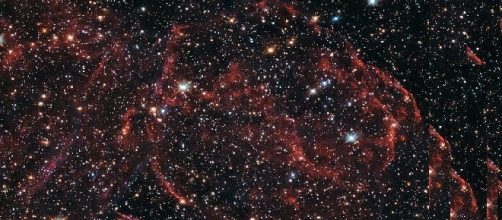NASA´s Hubble Space Telescope captured the image of what is left of a death star. The fragments of ionized gas known as DEM L316A are at an approximate distance of 160,000 light years in the Large Megallanic Cloud (LMC). The LMC travels around the Milky Way as a satellite galaxy and is the fourth largest galaxy in the local group. The source of these conglomeration of left overs of a star are usually caused by a supernova explosion known as type 1A.
Type 1A supernova
This type of supernova is known to occur in binary systems, where one of the stars is a white dwarf, while the other may be any star or another white dwarf.
When a slowly rotating carbon-oxygen white dwarf has accreted sufficient matter from a companion star, it becomes unbalanced upon reaching the Chandrasekhar limit of 1.4 solar masses. At this point it collapses under its own weight, releasing a great amount of energy, ejecting the star´s outer layers into the surrounding space environment.
As the expelled material expands into the neighboring space environment, it raises its temperature and ionizes it, then a faint glow is produced, such as the one captured by Hubble in the image. On clear starry nights, The LMC expands 36° across the night sky. Supernova explosions are some of the most powerful in the whole universe and very brilliant too.
DEM L316A
This galaxy encompasses two supernova explosions and their left overs. The hot gas remnant of the upper left side of the above Hubble image comprises an abundance of iron, suggesting that this portion of supernova remnant is the product of a supernova type 1A, while the scarce portions show less abundance of iron, indicating that they were produced by a supernova type 11.
LMC galaxy
This galaxy is a barred spiral galaxy that orbits the Milky Way and lies at approximately 160,000 light years of distance from earth. It´s the third closest galaxy to the Milky Way. It measures 14,000 light years across and possesses a mass of approximately 10 billion solar masses. It is faintly visible in the southern hemisphere.
It has an abundance of gas and dust and in the present is undergoing dynamic star formation.
The new discoveries of NASA´s Hubble Space Telescope broaden our understanding of the universe and disclose outstanding views in cosmology, increasing our general view in astronomy.

